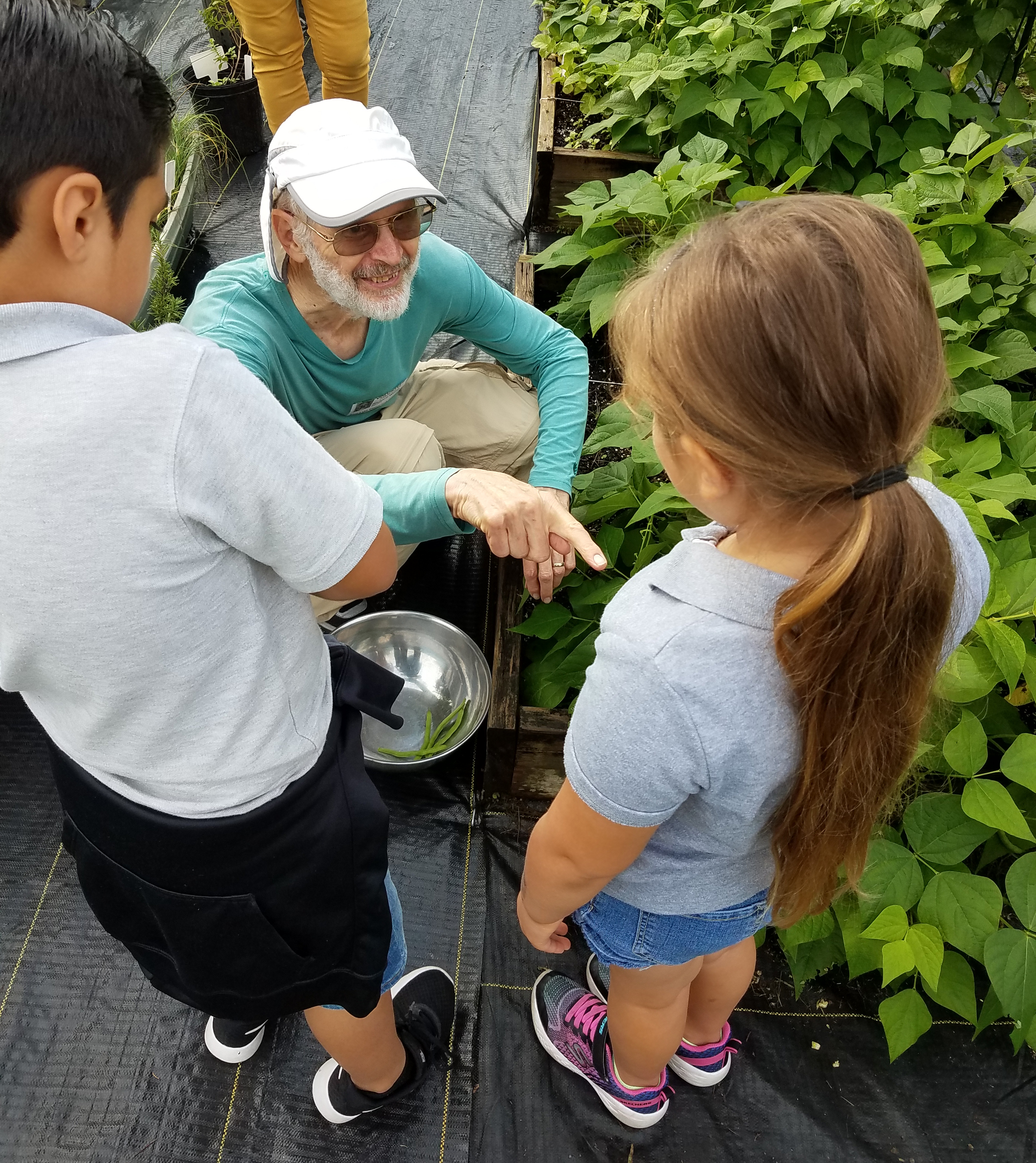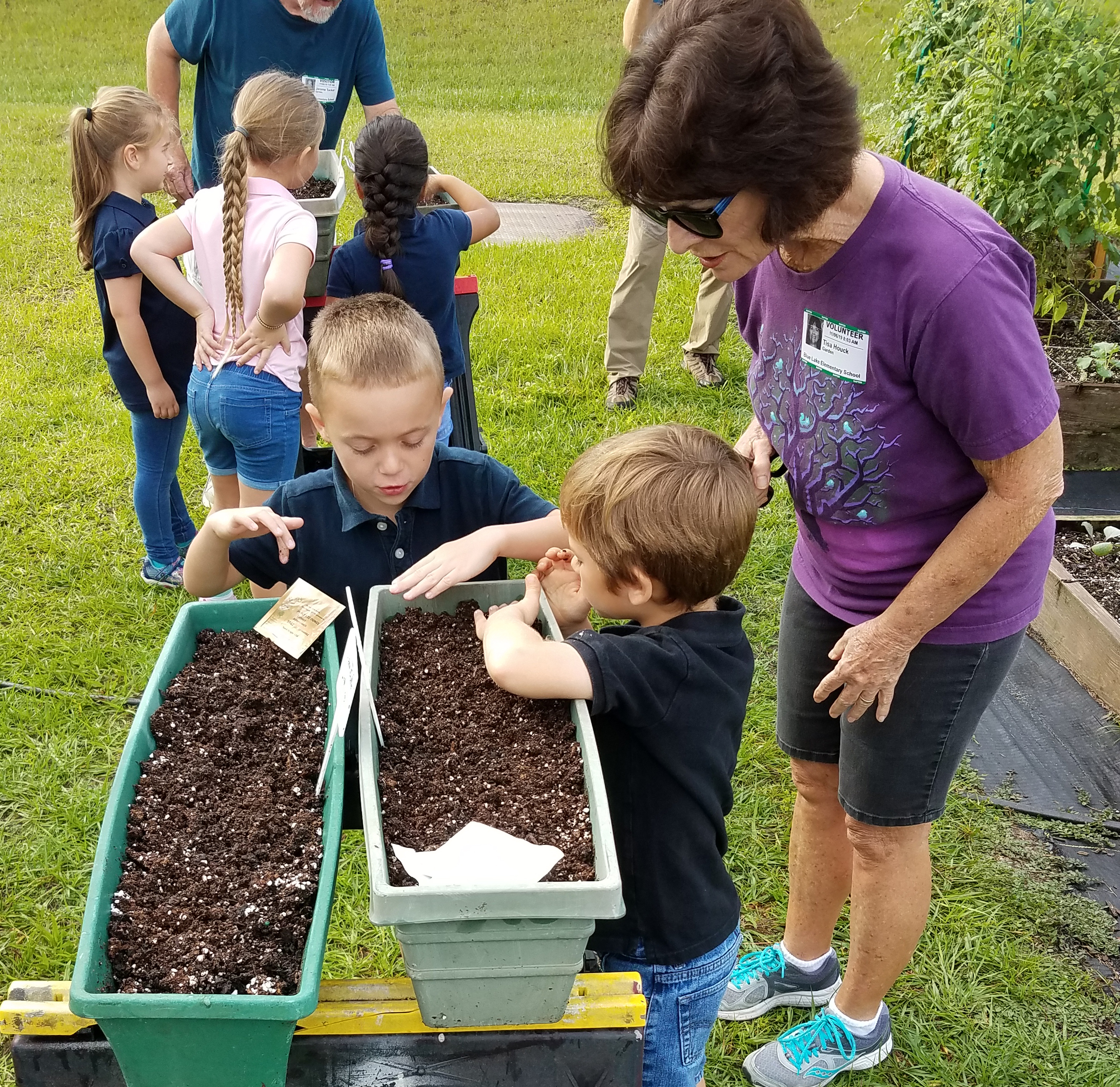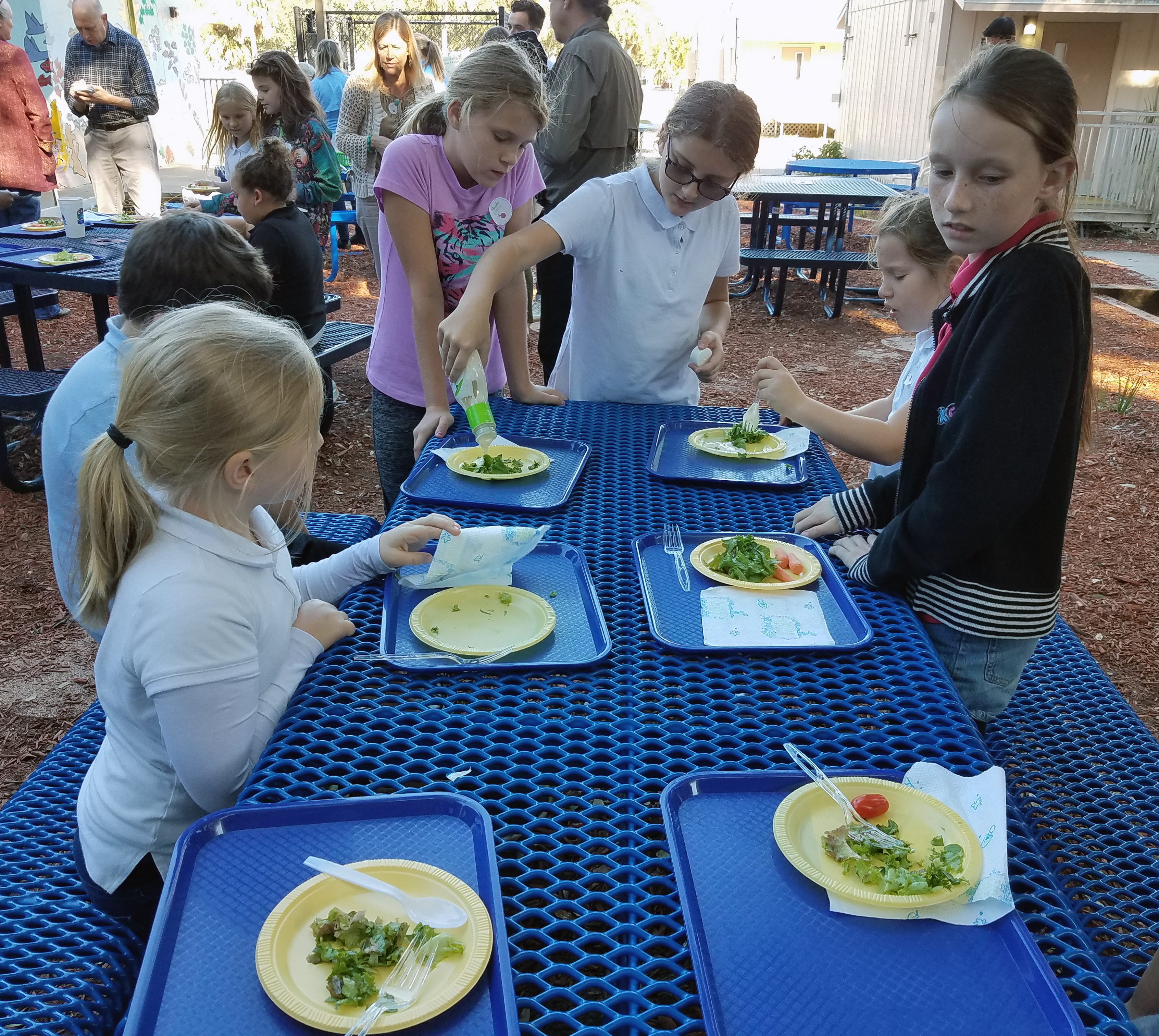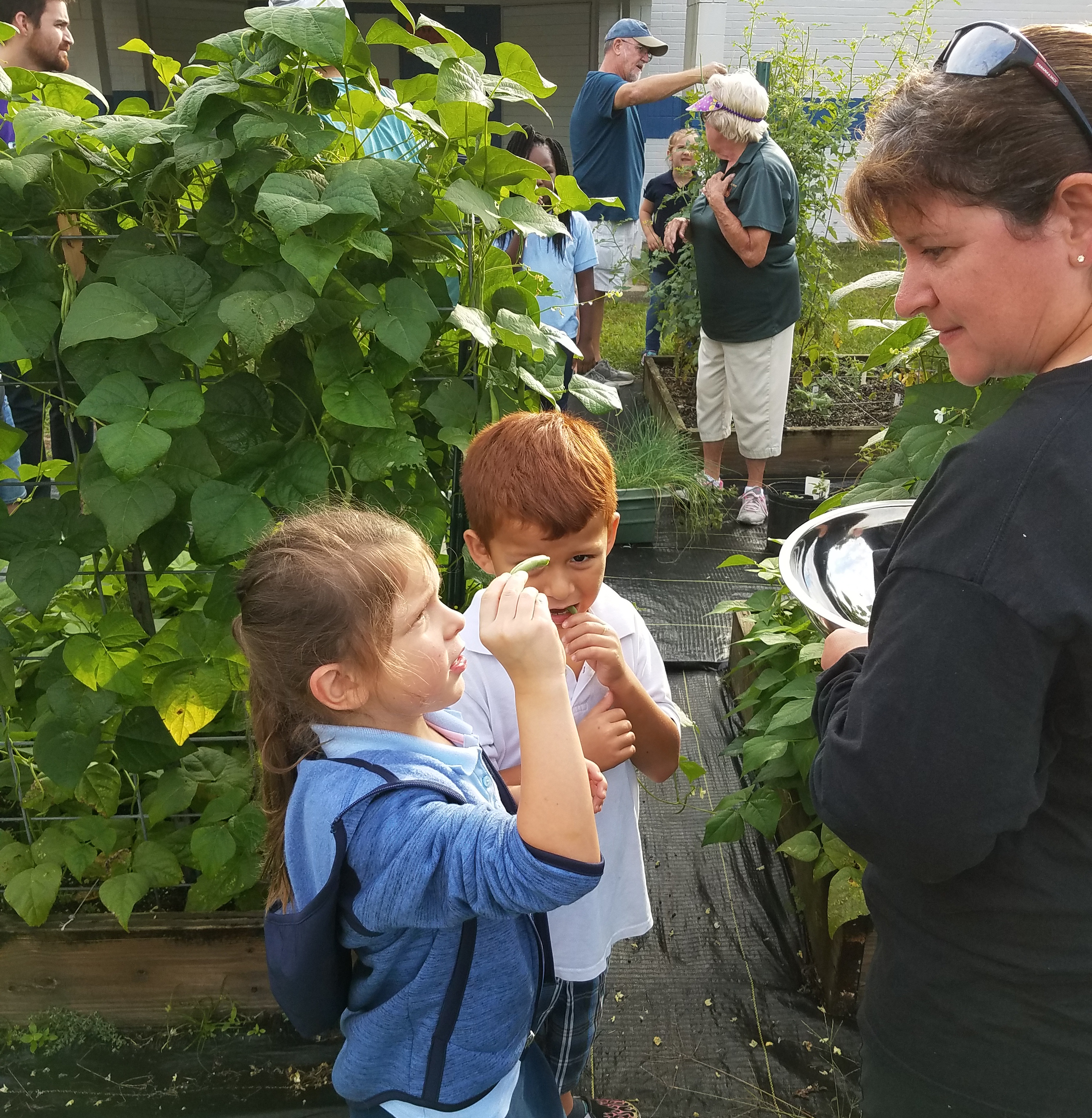Volusia’s school gardens: teaching nutrition and a whole lot more
Posted On: November 21, 2019
 They have a calming effect, teach practical life lessons in sustainability practices and help foster critical thinking, problem-solving skills and academic learning in areas as diverse as chemistry, math, biology, ecology, reading comprehension and recycling.
They have a calming effect, teach practical life lessons in sustainability practices and help foster critical thinking, problem-solving skills and academic learning in areas as diverse as chemistry, math, biology, ecology, reading comprehension and recycling.
Who knew vegetables could do all that?
As it turns out, the admonishment from your parents to eat your vegetables did a lot more good than most people realized at the time. Today, thousands of Volusia County school children are learning about good nutrition and healthy eating – and a whole lot more – as part of a vibrant gardening program that’s yielding delicious dividends both in the classroom and out. Through a partnership with the County of Volusia, the University of Florida/Volusia County Extension Service and Volusia County Schools, young students at a dozen schools in the county are growing vegetables, fruits and herbs – and learning important life lessons along the way. That’s because the science of gardening embodies just about every intellectual discipline you can think of.
“You can use a garden to teach just about anything,” according to Patrick Zayas, a program manager based in DeLand who oversees the Extension Service’s family nutrition program in Volusia County. “We’re teaching nutrition education. But at the end of the day, these gardens also serve as tools for teaching a lot more than that.”
The campus crops being grown at 11 elementary schools and one K-8 charter school in Volusia County run the gamut, from staples like lettuce, tomatoes, onions, carrots, cucumbers, green beans, spinach, squash and radishes to the exotic – star fruit and Japanese plums. And while they promote balanced eating and healthy living, the gardens are also used as symbols and metaphors and teachable moments that go way beyond the five basic food groups and what we put into our bodies.
“These school gardens provide students with a hands-on approach – learn by doing,” said Extension Director Sharon Gamble. “This is a way to get people to relate to where their food is coming from.”
 Through a federal act, the University of Florida is part of a series of colleges across the country that have been commissioned to extend their learning and research outside of the university setting and into the community so the general public can also benefit from all of that scholarly pursuit of knowledge. In partnership with local governments, UF has established Extension offices in all 67 counties in Florida to provide educational services covering topics such as natural resources, livestock, commercial and urban horticulture and family and consumer counseling. The county is UF’s partner in Volusia County through Volusia’s Community Services Division, which funds a variety of housing and neighborhood assistance programs.
Through a federal act, the University of Florida is part of a series of colleges across the country that have been commissioned to extend their learning and research outside of the university setting and into the community so the general public can also benefit from all of that scholarly pursuit of knowledge. In partnership with local governments, UF has established Extension offices in all 67 counties in Florida to provide educational services covering topics such as natural resources, livestock, commercial and urban horticulture and family and consumer counseling. The county is UF’s partner in Volusia County through Volusia’s Community Services Division, which funds a variety of housing and neighborhood assistance programs.
And the school gardens project, according to Volusia County Community Services Director Dona Butler, is a perfect pairing of two organizations, the county and the university, that share the same mission -- making people’s lives better.
“By combining and sharing resources, the county’s partnership with the extension office brings great value to the programs and services that we’re able to provide to the community,” said Butler. “At their core, the school gardens are all about lifestyles and healthy choices. They’re just one example of how we’re working together with our many partners to improve lives.”
Family nutrition, one of the local programs managed through the Volusia County extension office, helps low-income residents learn about good nutrition and how to stretch their food dollars. And how better to do that than by the creation of school gardens. The garden program encompasses 11 elementary schools in DeLand, Deltona, Daytona Beach, Ormond Beach, New Smyrna Beach and Port Orange and a charter school in Oak Hill, based in part on the percentage of students at each school who qualify for free or reduced lunches. Many of the students come from families raised on junk food and fast food. The school gardens program aims to change that.
“We’re trying to educate people on how to eat healthy on a budget,” said Zayas. “The goal is disease prevention and reducing obesity in both children and adults. We’re trying to change habits.”
 The importance of healthy, nutritious eating was on full display recently, as all five first grade classes took turns tending and harvesting the gardens at Blue Lake Elementary School. First up was Meredith Kelly’s class, as the 16 children – directed by about a half-dozen master gardeners – eagerly helped pick green beans, pole beans and cucumbers, prune vines, pull weeds and plant fresh seeds in the garden. As they worked their miniature farm, each student took a turn trying the fresh green beans and most seemed to find it surprisingly pleasurable. All the while, they received a steady dose of encouragement and education from the gardening volunteers.
The importance of healthy, nutritious eating was on full display recently, as all five first grade classes took turns tending and harvesting the gardens at Blue Lake Elementary School. First up was Meredith Kelly’s class, as the 16 children – directed by about a half-dozen master gardeners – eagerly helped pick green beans, pole beans and cucumbers, prune vines, pull weeds and plant fresh seeds in the garden. As they worked their miniature farm, each student took a turn trying the fresh green beans and most seemed to find it surprisingly pleasurable. All the while, they received a steady dose of encouragement and education from the gardening volunteers.
“Do you remember what this is? Can you tell me?”
“Cover it up and pat it down. Good job. Now make some more holes.”
“Do you want to cut this one? Good job!”
“This is called chives. I want you to chew it and tell me what it tastes like.”
“This is called stevia. You can use it instead of sugar.”
The experience isn’t just educational for the children, it’s fun. “My kids really look forward every week to working in the garden,” said Ms. Kelly. “They’re getting a love of planting and gardening and tasting new things. That’s what I really like.”
And for the master gardeners, brought in through the Volusia County Extension Service, it’s also an immensely satisfying experience. It’s a good thing, since it’s all volunteer work. “It’s just very rewarding for all of us,” said Julie Warner, the lead volunteer master gardener at Blue Lake. “We don’t get paid. Our pay is just seeing the children’s faces light up.”
The 12 gardens that the program is supporting this school year range from basic – a few growing boxes, seeds and potting soil and just one or two different vegetables – to extremely elaborate, complete with greenhouses, self-watering garden containers, composting barrels, hydroponic set-ups and a dozen or more different crops, all with different needs and growing seasons. The garden at Osceola Elementary School in Ormond Beach includes a hydroponic growing tower powered by a solar panel. At the Burns Science and Technology Charter School in Oak Hill, their garden features two greenhouses for starter seedlings and an aquaponics system with live fish that feeds nutrient-rich water filled with fish feces into the soil to help the plants thrive. And at Sugar Mill Elementary School in Port Orange, they’re growing everything from tomatoes, green peppers, eggplants, arugula, star fruit, Japanese plums, beets and basil to zucchini, thyme, parsley, papaya, mangos, sweet potatoes, oregano, okra and avocados. Their garden also sports 150 hydroponic strawberry plants and microgreens, or miniature, sprout-like versions of vegetables that are grown in the cafeteria and then assimilated into the school’s lunch offerings. Sugar Mill even has an after-school cooking class to teach students how to integrate their crops into meal time.
 The extension office helps each school set up their garden the way they want it and then provides ongoing technical assistance to both teachers and students through master gardeners as well as classroom instruction on nutrition education. Some schools prefer to keep their gardens small and easily manageable, with just one teacher and one class involved. Others involve every grade and even have after-school clubs to enhance the educational experience beyond what they can cram into the regular school day. Like most things, school gardens isn’t a one-size-fits-all endeavor. “We try to meet the individual needs of each participating school,” explained Zayas.
The extension office helps each school set up their garden the way they want it and then provides ongoing technical assistance to both teachers and students through master gardeners as well as classroom instruction on nutrition education. Some schools prefer to keep their gardens small and easily manageable, with just one teacher and one class involved. Others involve every grade and even have after-school clubs to enhance the educational experience beyond what they can cram into the regular school day. Like most things, school gardens isn’t a one-size-fits-all endeavor. “We try to meet the individual needs of each participating school,” explained Zayas.
At each school, the gardens are strategically placed near the participating classrooms to make their location convenient for students and teachers tending to the plants and regularly walking by to check on their growth. A great deal of thought goes into decisions on what to plant. For instance, tomatoes require a lot of care and about a month or two to mature. Conversely, radishes quickly sprout about 22 days after planting. Either way, the idea is to expose children to new foods like garden-fresh vegetables that they might not ordinarily have in their diets. The pay-off comes when they get to eat what they’ve grown. Sometimes, it’s a bite into a tomato or dining on a green salad. Other times, the harvested goodies are whipped up into tasty treats, like fresh salsa. The foods they grow, though, don’t require cooking. The program prefers to let the students sample creations right out of the ground, all washed and ready for consumption. Hopefully, the experience creates new and healthier eating habits. The students might even go home and influence their parents to eat healthier.
“The kids are dying to try the foods because they grew it,” said Zayas. “They really get a kick out of it. Hopefully if a kid, for instance, tries broccoli because of our program and likes it, then they’ll be more likely to eat more of it. That’s really what we want.”
Another thing that Zayas wants is for the students to gain an understanding of the sources of the foods they eat. “The program not only tries to instill healthy nutritional habits, but it also teaches the kids that their food doesn’t come from the back of a grocery store. It comes from a farm.”
As valuable as these lessons are, the program teaches students way more than good nutrition and the source of the food they eat. The gardens are also fashioned into educational tools for teaching just about every subject under the sun. For instance, gardens are used to teach math concepts like the volume of soil, the square footage of a grow area and how many of each type of plant it can support. They’re used to teach history, as in the history of vegetables and where they come from. For the younger students, they brush up on their reading skills by reading stories about plants, farming and food sources. The students also learn about recycling, since some of the gardens recycle newspapers by stuffing them into their planters as a way to help the roots retain moisture. The gardens are used to teach the science of plant life and the science behind various growing techniques. They’re also used to teach plant biology, the physics of soil and the chemistry behind how different fertilizers break down. “There’s a lot of science that goes into agriculture,” explained Director Gamble. “You can use agriculture to teach a lot of the basic STEM education,” a reference to the core curriculum subjects of science, technology, engineering and math that are collectively referred to by the STEM acronym.
 At Sugar Mill Elementary School, Dr. Marie Bracciale – affectionately known as Dr. B. – has found a somewhat unique way to incorporate the school’s massive garden into her mission as the campus counselor. She refers to their planting patches as “therapeutic, edible gardens,” and a walk around the campus with Dr. B. shows why. In perpetual motion, Bracciale navigated the campus at a frenetic pace, carting around soil and gardening tools, checking on planting boxes, watering systems and mulch piles, all the while inspecting the progress of the gardens. But she never misses an opportunity to stop along the way to connect with the students and deliver a message about agriculture or proper watering techniques – or discipline, when called for. On this day, she stopped to show a group of students how to water the plants, instructing them to always pour the water on the bottom, near the roots.
At Sugar Mill Elementary School, Dr. Marie Bracciale – affectionately known as Dr. B. – has found a somewhat unique way to incorporate the school’s massive garden into her mission as the campus counselor. She refers to their planting patches as “therapeutic, edible gardens,” and a walk around the campus with Dr. B. shows why. In perpetual motion, Bracciale navigated the campus at a frenetic pace, carting around soil and gardening tools, checking on planting boxes, watering systems and mulch piles, all the while inspecting the progress of the gardens. But she never misses an opportunity to stop along the way to connect with the students and deliver a message about agriculture or proper watering techniques – or discipline, when called for. On this day, she stopped to show a group of students how to water the plants, instructing them to always pour the water on the bottom, near the roots.
“Don’t put the water on the top. It makes them get fungus,” Bracciale told the kids. “Let me show you,” she said, as she grabbed a water bucket and a plant to demonstrate.
After a few minutes, Bracciale moved on, calling out to a teacher in the distance that the eggplants and tomatoes have come in. “Alright, I like the sound of all that,” the teacher gleefully responded. Bracciale continued on her rounds, accompanied much of the morning by a pint-sized assistant – a little boy named Jackson. Bracciale maintained a running dialogue throughout with Jackson, who was helping spread some soil.
“Did you put some in, Jackson?”
“Put the shovel in the cart, Jackson.”
“I’m watching that you’re listening to what I say, Jackson.”
As they walked past a papaya tree, Jackson volunteered: “I eat those at my house.”
But when Jackson wanted to help pick a ripened papaya from the tree, Bracciale wasn’t quite ready to bestow that honor upon Jackson. Apparently the little boy had been acting out earlier in the day. “He’s got to wait,” said Bracciale. “He’s not having a great day. He’s going to have to earn it from me.”
Asked how she incorporates the gardens into her counseling duties, Bacciale pointed to Jackson. “He was all balled up, wanting to hit somebody,” said Bacciale. “As soon as they get in the garden, they’re completely calm. That’s why I call them therapeutic gardens.”
All of that agriculture therapy, nutrition instruction and ancillary educational opportunities provided by the gardens, none of it would be possible without the partnership between the county and the University of Florida/Volusia County Extension. The staff is jointly funded by the county and the university along with state and federal grants, and it’s money well spent – an investment in children. “I really like the gardens. It’s one of the most rewarding things that we do,” said Zayas. “It’s a great partnership we have with the county. I love it!”
It’s a sentiment echoed by Gamble, who’s thankful to have such a good working relationship and strong support from the county. “It’s because of the support of the county that we’re able to do these things for the community,” added Gamble. “The extension service wouldn’t be here without the county’s support.”

